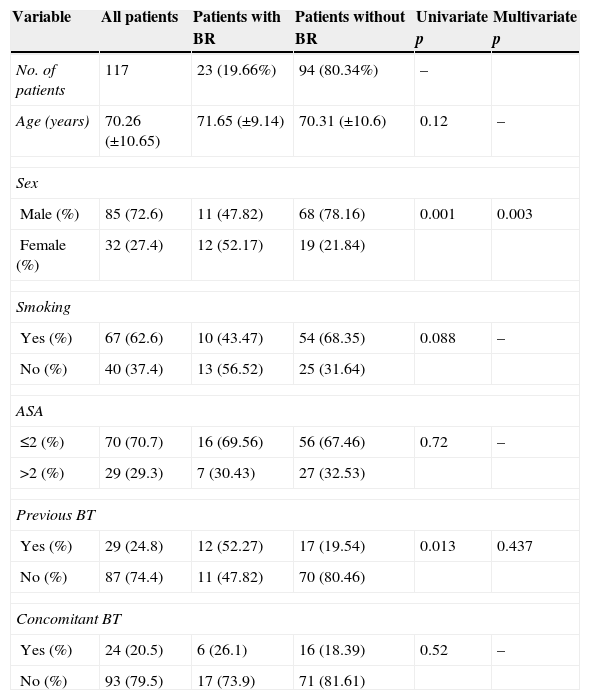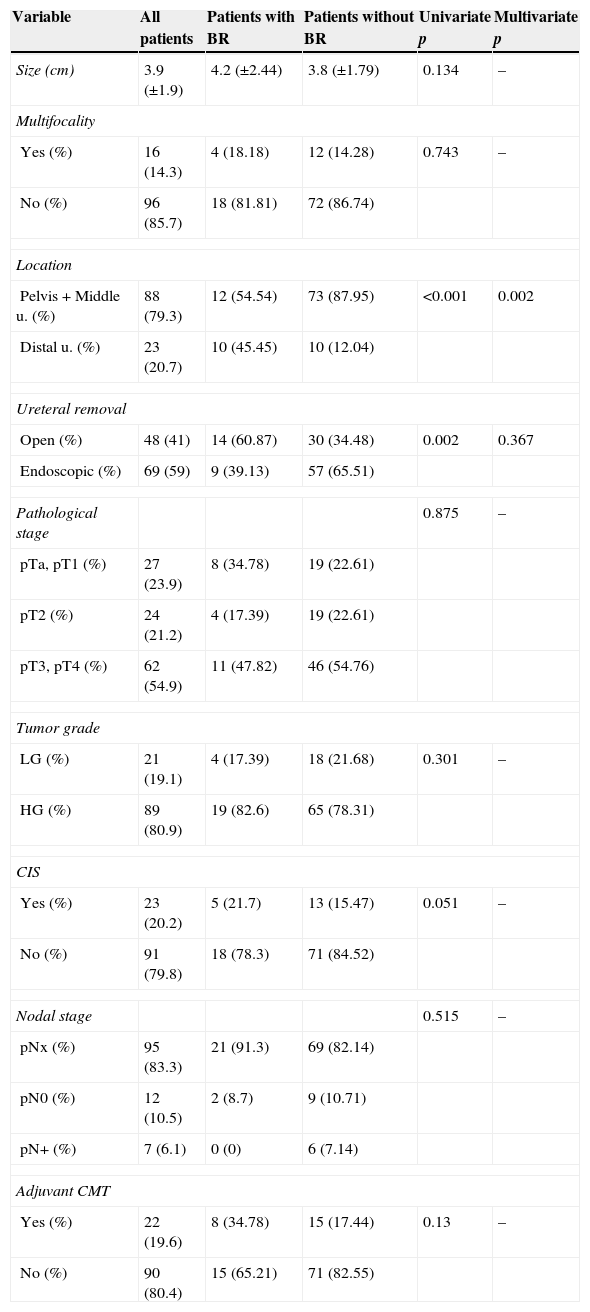To analyze the predictors for bladder recurrence (BR) after nephroureterectomy (NU) for upper urinary tract tumors (UUTT), as well as its pathological characteristics, outcomes and impact on survival.
Material and methodsRetrospective study of 117 patients who underwent laparoscopic nephroureterectomy by UUTT between 2007 and 2012 at our center. The potential predictors for BR were analyzed using Cox regression; Kaplan–Meier curves were employed to study survival.
ResultsThe sample was composed of 85 men (73%) and 32 women (27%), with a mean age of 70 years. After a mean follow-up of 26 months, 23 patients presented BR (19.6%). In the multivariate analysis, sex (p=0.003; HR [female], 3.8) and the location of the UUTT in the distal ureter (p=0.002; HR, 4.8) were independent predictors for BR.
The median time to BR was 8 months. Fifteen patients presented a nonmuscle-invasive BR (65.2%), and 8 presented a muscle-invasive BR (34.8%). All BRs, except for 2, appeared during the first 2 years. Five cases with nonmuscle-invasive BR presented a new BR. Six patients with muscle-invasive BR died before it could be determined whether cause of death was the BR or an UUTT relapse. The onset of BR showed no repercussion on the survival of patients with UUTT.
ConclusionsSex (female) and the location of the UUTT (distal ureter) are predictors for BR after NU. Patients with these characteristics might benefit from adjuvant intravesical treatment and closer monitoring. The onset for RV has no impact on the survival of patients with UUTT.
Analizar las variables predictoras de recidiva vesical (RV) tras nefroureterectomía (NU) por tumor de tracto urinario superior (TTUS), así como sus características patológicas, evolución y repercusión en supervivencia.
Material y métodosEstudio retrospectivo de 117 pacientes sometidos a NU laparoscópica por TTUS entre 2007-2012 en nuestro centro. Los posibles factores predictores de RV se analizaron mediante regresión de Cox y para el estudio de supervivencia se utilizaron las curvas de Kaplan-Meier.
ResultadosFueron 85 hombres (73%) y 32 mujeres (27%) con una edad media de 70 años. Tras un seguimiento medio de 26 meses, 23 presentaron RV (19,6%). En el análisis multivariante, el género (p=0,003; HR mujer 3,8) y la localización del TTUS en uréter distal (p=0,002; HR 4,8) fueron predictores independientes de RV.
La mediana de tiempo hasta la RV fue de 8 meses. Quince pacientes presentaron una RV no músculo-invasiva (65,2%) y 8 músculo-invasiva (34,8%). Todas las RV excepto 2, aparecieron durante los primeros 2 años. Cinco casos con RV no músculo-invasiva presentaron nueva RV. Seis pacientes con RV músculo-invasiva murieron sin poderse definir si fue por tumor vesical o de vías. La aparición de RV no mostró repercusión en la supervivencia de los pacientes con TTUS.
ConclusionesEl género (mujer) y la localización del TTUS (uréter distal) son factores predictores de RV tras NU. Pacientes con estas características podrían beneficiarse de tratamiento adyuvante intravesical y de un seguimiento más estricto. La aparición de RV no tiene impacto en la supervivencia de los pacientes con TTUS.
Artículo
Comprando el artículo el PDF del mismo podrá ser descargado
Precio 19,34 €
Comprar ahora









